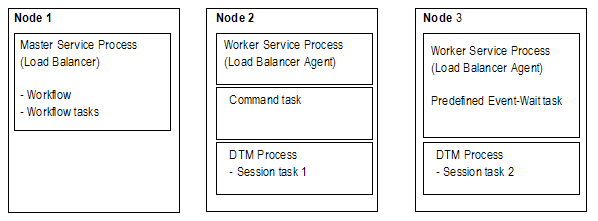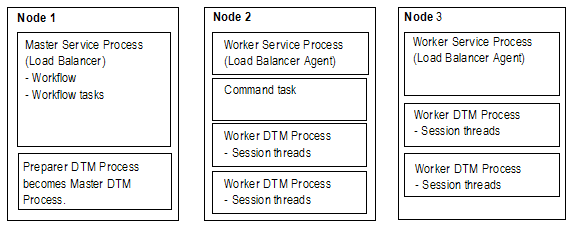Grids
When you run a PowerCenter Integration Service on a grid, a master service process runs on one node and worker service processes run on the remaining nodes in the grid. The master service process runs the workflow and workflow tasks, and it distributes the Session, Command, and predefined Event-Wait tasks to itself and other nodes. A DTM process runs on each node where a session runs. If you run a session on a grid, a worker service process can run multiple DTM processes on different nodes to distribute session threads.
Workflow on a Grid
When you run a workflow on a grid, the PowerCenter Integration Service designates one service process as the master service process, and the service processes on other nodes as worker service processes. The master service process can run on any node in the grid.
The master service process receives requests, runs the workflow and workflow tasks including the Scheduler, and communicates with worker service processes on other nodes. Because it runs on the master service process node, the Scheduler uses the date and time for the master service process node to start scheduled workflows. The master service process also runs the Load Balancer, which dispatches tasks to nodes in the grid.
Worker service processes running on other nodes act as Load Balancer agents. The worker service process runs predefined Event-Wait tasks within its process. It starts a process to run Command tasks and a DTM process to run Session tasks.
The master service process can also act as a worker service process. So the Load Balancer can distribute Session, Command, and predefined Event-Wait tasks to the node that runs the master service process or to other nodes.
For example, you have a workflow that contains two Session tasks, a Command task, and a predefined Event-Wait task.
The following figure shows an example of service process distribution when you run the workflow on a grid with three nodes:
When you run the workflow on a grid, the PowerCenter Integration Service process distributes the tasks in the following way:
- •On Node 1, the master service process starts the workflow and runs workflow tasks other than the Session, Command, and predefined Event-Wait tasks. The Load Balancer dispatches the Session, Command, and predefined Event-Wait tasks to other nodes.
- •On Node 2, the worker service process starts a process to run a Command task and starts a DTM process to run Session task 1.
- •On Node 3, the worker service process runs a predefined Event-Wait task and starts a DTM process to run Session task 2.
Session on a Grid
When you run a session on a grid, the master service process runs the workflow and workflow tasks, including the Scheduler. Because it runs on the master service process node, the Scheduler uses the date and time for the master service process node to start scheduled workflows. The Load Balancer distributes Command tasks as it does when you run a workflow on a grid. In addition, when the Load Balancer dispatches a Session task, it distributes the session threads to separate DTM processes.
The master service process starts a temporary preparer DTM process that fetches the session and prepares it to run. After the preparer DTM process prepares the session, it acts as the master DTM process, which monitors the DTM processes running on other nodes.
The worker service processes start the worker DTM processes on other nodes. The worker DTM runs the session. Multiple worker DTM processes running on a node might be running multiple sessions or multiple partition groups from a single session depending on the session configuration.
For example, you run a workflow on a grid that contains one Session task and one Command task. You also configure the session to run on the grid.
The following figure shows the service process and DTM distribution when you run a session on a grid on three nodes:
When the PowerCenter Integration Service process runs the session on a grid, it performs the following tasks:
- •On Node 1, the master service process runs workflow tasks. It also starts a temporary preparer DTM process, which becomes the master DTM process. The Load Balancer dispatches the Command task and session threads to nodes in the grid.
- •On Node 2, the worker service process runs the Command task and starts the worker DTM processes that run the session threads.
- •On Node 3, the worker service process starts the worker DTM processes that run the session threads.


